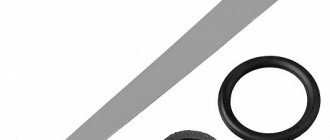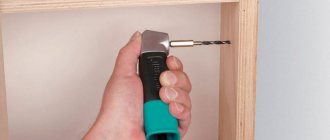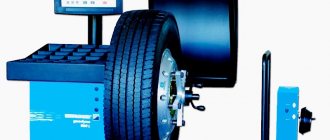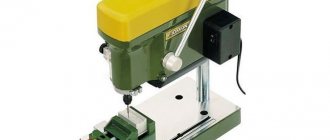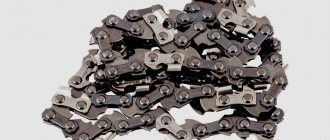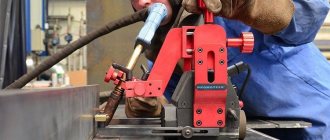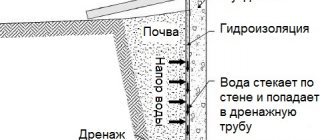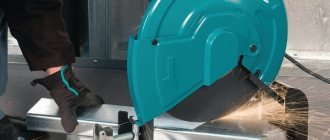The bolt breaks off when it is turned sharply or due to other careless actions. The whole difficulty of this situation lies in the fact that part of the fastener is firmly stuck in the inlet hole and is very difficult to remove without special tools. Sometimes it is still possible to pick up a piece of a bolt with pliers and unscrew it, but using an extractor will be much better and more efficient, i.e. a special tool designed for unscrewing bolts.
Bolt extractor - general information
It is a device that is used to unscrew broken bolts. The extractor looks like a steel rod, at one end of which there is a wedge or left-hand thread. The shape of this tool is very similar to a beard or hammer. The sizes of extractors vary and this parameter will depend on the diameter of the bolt that needs to be extracted. Experts recommend not limiting yourself to having just one extractor in your household, but rather stocking up on a whole set at once in order to be prepared for any non-standard situation (usually the set includes devices for working with threads for sizes from M1 to M6). To properly unscrew the fastener, you first need to hook it. For these purposes, a recess is made in the center of the stud using a drill - it will be needed for further jamming of a conical or cylindrical tool in it, with the help of which the stuck element will be removed.
Modern types of extractors
Depending on the operational and design features, bolt screws are divided into the following modifications:
- Wedge-shaped - they have a conical faceted shape and work on the principle of a simple wedge, which is driven into the existing hole on the broken base of the stuck fastener. After driving in and fixing the device, it must be gradually turned with a wrench. Using this model does not cause any difficulties, the main thing is to take into account that the hole for screwing out should be located directly in the center of the base of the fastener. If this rule is violated, the forces applied during rotation will be displaced, and this, in turn, will not allow the broken element to be removed. In addition, there is a risk of damage to the extractor itself.
- Rod - these devices have the appearance of a faceted rod and their operating principle is very similar to a wedge-shaped tool. They also need to be driven into the drilled hole in the broken pin, then wedged and turned out using a key. The main disadvantage of the rod type is some difficulty in removing the twisted part.
- Spiral-screw - are the most common type, effective and easy to use. They also have a conical shape, on which a right or left thread is already applied (for unscrewing all types of threads). Such extractors are not driven into the part, but are carefully screwed into the hole in the fastener, after which they are wedged and, together with the fastener, are removed simultaneously and evenly. It should be noted that using a spiral screw extractor in conjunction with a wrench will require a special wrench.
Fastener Removal Tool Kits
Such kits are very easy to find in any specialized hardware store. Naturally, it is more practical to purchase a whole set at once than to purchase individual tools. Sets with the “station wagon” brand have become very popular, because with their help, the physical and time costs of unscrewing various bolts can be easily minimized, despite the complexity of the current situation. Such kits contain not only extractors with different diameters, but also additional tools necessary for unscrewing broken bolts, such as:
- Drivers or wrenches;
- Drill;
- Bushings for wrenches;
- Bushings to maintain the direction of the drill in relation to the center of the broken stud.
The components of such kits are durable and especially reliable, as they are made of hardened or chrome-plated steel.
Device and device types
The range of popular models is impressive. However, regardless of the manufacturer, there are two types of extractors for metalwork:
- internal;
- external (external).
Internal devices are divided into the following subtypes:
- one-sided;
- double sided
The internal devices have an oblong shape. Working end one or two. Single-sided screwdrivers are equipped with one wedge-shaped or cone-shaped working area with a right (left) thread and a short pitch. The second side is equipped with a shank in the form of a square or hexagon. On sale there are one-sided models, on the back of which a head with a hexagonal or square mouth is attached.
Both ends of double-sided extractors are working. On one side there is a short drill. They drill holes of the required diameter. The other end is equipped with a left-handed tapered thread. Bilateral devices are available in small sizes. They look like screwdriver bits.
The kits may contain guides for external devices that are used for precise alignment. This allows you to avoid damaging the body of the object during careless manipulations.
The external products resemble impact sockets for impact wrenches. However, there are sharp edges inside them, reminiscent of smooth curls. The socket impact heads are devoid of such elements. Some mechanics use impact wrench sockets to remove broken bolts. This leads to premature failure of the device.
All manufactured products are divided into three main categories:
| Kinds | Description |
| Rod | A device in the form of a rod with sharp edges. It is hammered into a pre-prepared hole so that it can then become wedged in it. Unscrews with a wrench. The main disadvantage is that it is difficult to remove from the broken part. |
| Wedge-shaped | Cone-shaped devices with edges. First, a hole is drilled in the damaged fastener, and then this extractor is hammered in with a hammer. After it is jammed, removal occurs using a wrench. A review of the reviews shows that there is nothing complicated in the manipulations, however, experts recommend not to lose sight of one point: the device is hammered precisely in the center of the broken part, and this is not always possible. Sometimes you have to deal with the problem of unscrewing the bolt itself from the fixture. |
| Screw spiral | Cone-shaped models with special threads cut on the surface. The direction of the thread varies. Options for using devices vary. The left-hand thread helps to remove fasteners with a right-hand thread, the right one is suitable for removing broken bolts with a left-hand thread. This device does not need to be hammered. It is twisted inside the drilled hole, jammed there and pulled out along with the damaged part. The work requires the use of a special wrench and the application of maximum effort. |
Technology for unscrewing broken bolts
Even a beginner can remove broken fasteners from the base using an extractor. The main thing is to consistently follow all the structural steps of the extraction process. First of all, you should make a mark in the center of the broken fastener, for which you use a punch and a hammer. Then you need to drill a hole where the extractor will be inserted. In this case, the diameter of the future hole is taken into account, since it must correspond to the diameter of the extractor. For this purpose, a special guide bushing is used, which is supplied in the extractor kit. Then you need to install the extractor in the hole you have made, and fix it by tapping it with a mallet or hammer. Next, the extractor is screwed into the hole of the broken fastener using a driver, tap or wrench (all the way). Having screwed the extractor to the limit, you can begin to remove the bolt.
IMPORTANT! It is always worth remembering that you need to rotate the tool only in the direction of the axis, because any displacement will lead to breakage of the device.
Upon completion of eversion, the extractor is carefully removed, preventing damage to the edges of the wedge equipment. If a screw type was used, then the bolt is simply unscrewed. To facilitate the removal process, it is allowed to use a wrench or pliers.
Some features of the application of bolt extraction technology
Depending on the current situation, the technology for removing a broken bolt may vary depending on the location where it is stuck:
- Below the plane of the base - in this case, you first need to insert a sleeve into the resulting depth so that its diameter matches the hole. Then you need to drill a hole of the proper depth. If the stuck fastener has a large diameter, then small drills are used first to gradually drill out the hole. The final step will be driving in the rod and installing the sleeve to remove the fastener.
- Above the base plane - in this situation, all the same actions are performed as in the previous one. First, the sleeve is directed and installed, only then a hole is drilled to install the rod, which will remove the stuck bolt.
- At the same level with the base - here you will have to use a center punch in order to correctly mark the center of the future hole. Then you need to drill a hole in the center, install the extractor and unscrew the pin.
Useful tips when working with threaded bolts
When unscrewing such broken fasteners, it is possible to somewhat simplify the work process:
- If you heat up a stuck product, removing it will take much less time;
- If the thread is broken, you can use a hex wrench to unscrew it;
- Before starting work, it is better to treat the broken part with some kind of lubricant - solvent, acetone or oil;
- Using drills with reverse threads it is very easy to remove a broken bolt;
- Using a core and hammer can be an effective step. The core is installed at an angle of 45 degrees to the broken bolt and is driven counterclockwise. This operation must be carried out on at least four sides, and then the fasteners must move.
Useful tips for removing threaded bolts
When using a screw driver for broken bolts, this process can be made a little easier by following these guidelines:
- To remove a bolt or stud faster, the product should be heated;
- if the screw thread is broken, you can use a hex wrench to unscrew it;
- Before starting work, treat the part with a lubricant - oil, acetone or rust solvent;
- When using drills with reverse threads, you can easily turn out the broken element.
- try using a core and hammer. Set the core at 45 degrees to the stuck bolt and tap it counterclockwise. This must be done in at least four places. If the element does not move, then use another method;
- If the actions to remove the bolt or stud were in vain, you will have to drill holes of large diameters and re-tap the threads.
As a result, it is worth noting that using the extractor correctly, you can remove any hopelessly broken bolts, studs and other fasteners. In addition, the cost of a single tool or set of extractors is quite affordable for any consumer . Therefore, when faced with frequent bolt breakdowns when working with fastening various structures, this type of device will become an indispensable assistant.
Benefits of using extractors
The use of this type of device for removing tightly stuck bolts has several undoubted advantages:
- The tool is quite simple to use: to handle it successfully, no special knowledge or skills are required;
- Sets of such tools are quite affordable, which indicates their universal popularity;
- The set includes most extractor tools with the most common diameters and sizes;
- Using this tool, you can quickly unscrew almost any damaged fastener stuck in a car body, furniture or equipment;
- If extractors are made of high-quality and durable steel, then the likelihood of their breakdown is very low, and on the contrary, their service life increases sharply.
Of course, not every bolt can be removed using an extractor - situations vary. The main thing is to follow the rule, which states that the material of the stuck element must be softer than the material from which the extractor is made.
Removing fasteners using an extractor
The key to a successful removal process for damaged fasteners is the design of the extractor. Despite the fact that each manufacturer has its own characteristics, none of them can do without a conical drill and several turns of left-hand thread. Without such a set, it will be impossible to remove a screw or screw with damaged splines.
The process is ridiculously simple. First you drill the damaged head, and then screw the extractor into it until it stops. After which the difference between the directions of tightening the extractor and unscrewing the screw will do its job.
Difficulty of choice
It’s worth mentioning right away that the quality of the equipment in question is the determining parameter that should influence the choice. Extractors should not be purchased randomly and without careful analysis of all their operating properties. The characteristics that determine the quality of the extractor include the strength properties of the material used to make it. The steel must be very hard, but not very brittle, otherwise the tool will simply break during operation. Only a few grades of steel from different manufacturers have such characteristics, but in their composition they are more or less very similar to each other. Unfortunately, some manufacturing companies from Asian countries make extractors from almost any type of steel that is somewhat durable. Indeed, such products have a lower cost, but their purchase will not bring much benefit, and the tool itself can only be used a couple of times, then it will break. Therefore, experts advise buying only those sets whose manufacturer does not raise reputational doubts, while at the same time paying attention to the markings of the steel used in the tools.
Modern samples of extractors are sold both separately and as part of various sets. Professionals recommend having a complete set with extractors of different diameters and sizes on hand, and it would also be nice if the kit comes with additional tools. Naturally, the cost of a high-quality and complete set may seem quite high, but all expenses will pay off after the first use.
Main characteristics of devices
It is worth noting that extractors are designed to perform strictly defined tasks. They help remove a fastener with a broken head from an object. An indispensable item for car repairs. Much attention should be paid to such properties as the reliability and strength of the material used in manufacturing. The product is produced from high-carbon steel, carbide metals, and high-speed steel. S2 tool steel, oxidized steel, high-strength chrome vanadium steel and other similar alloys are often used.
It is worth noting that underground manufacturers use soft metals to manufacture products, which makes the use of these tools for their intended purpose impossible. Therefore, it is necessary to pay special attention to the manufacturer and labeling. You should not contact little-known companies or those whose products have complaints. This is fraught with loss of money.
The weight of the device depends on the metal used in its manufacture, as well as on the parameters and type. Internal extractors have lengths from 26 to 150 mm. Conical tip in the range of 1.5 - 26 mm. The weight of the structure is 8 – 150 grams. External products are available in lengths from 16 to 26 mm, weighing about 100 - 150 grams.
There are no GOST standards for these locksmith devices. Each manufacturer relies on its own specifications. Well-known brands have personal laboratories where specialists develop the best composition of materials for the manufacture of professional-level instruments. Product markings are either missing or the diameter for which the tool is suitable is indicated.


